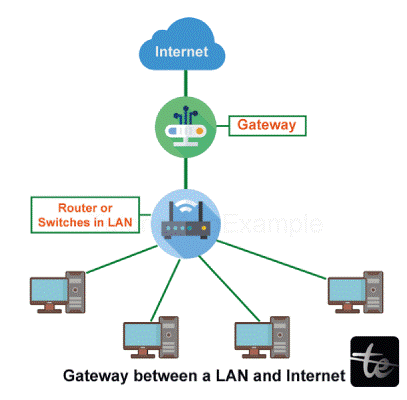What are Gateways in Computer Network?
What are Gateways in Computer Network?
A gateway is a network node that connects two networks using dissimilar transmission methods. The network gateway, which makes up the majority of gateway types, works at OSI's third layer, or the network layer. A gateway can, however, work at any of the seven levels of the OSI model, depending on its functioning. Since the gateway should be the place at which all traffic between networks flows, it serves as the network's entrance and departure points. In a LAN, the gateway only handles internal communication between the nodes; a computer that stands in the way of two networks or programs. The gateway transforms data, communications, and information from one protocol or format to another. Some of the duties of a gateway may be carried out by a router. Communications between a corporate network and the Internet can be transferred through an Internet gateway. A gateway frequently serves as a protocol converter so that users may send and receive messages via the Internet since local-area networks (LANs) used by businesses sometimes employ protocols that are different from those of the Internet function or product that uses exclusive techniques to connect several systems.

Working Procedure of Gateway
Every network has a border that prohibits connection with anything other than those linked directly to it. As a result, a network needs a gateway's capabilities if it wishes to connect with objects, nodes, or networks that are located beyond that barrier. The combination of a router and a modem is frequently used to describe a gateway.
The gateway is a component of a network's edge that controls all data directed from the network, whether it is for internal or external use. The data packet is transmitted to the gateway and then routed to the destination using the most effective route when one network wishes to interact with another. The host network's internal pathways and the paths of any other networks found are maintained by a gateway along with routing data.
Types of Gateways
Here we are discussing some important types of Gateways
- Unidirectional Gateway: Data can only pass via unidirectional gateways in one direction. The destination node replicates changes made in the source node but not the other way around. They are tools for archiving.
- Bidirectional Gateway: Data can pass through bidirectional gateways in both directions. They are instruments for synchronization.
- Web application firewalls: This kind examines data at the application layer while filtering traffic to and from a web server.
- Gateways for cloud storage: These types transform storage requests into calls to various cloud storage provider APIs. It enables businesses to incorporate private cloud storage into apps without switching to a public cloud.
- API Gateway: Gateways that control traffic entering and leaving a service, a micro services-oriented architecture, or an XML-based web service are known as API, SOA, or XML gateways.
- Media gateways: This kind transforms data between the formats required by different types of networks.
- Email security gateways: These stop emails from being sent that violate business policy or are intended to convey sensitive information.
- VoIP trunk gateways: This kind enables the use of standard telephone equipment with a voice over IP (VoIP) network, including landlines and fax machines.
Features of gateway
- The gateway controls all data entering or leaving a network from its position at its edge.
- Between two distinct networks using various communication methods, it creates a route.
- The function of a gateway is that of a protocol converter, ensuring interoperability between the many protocols used by the two separate networks.
- A gateway's capacity to function at any OSI model layer sets it apart from other network devices.
- Additionally, information on the communication networks' routing pathways is stored there.
- A gateway node may be used in addition to a proxy server or firewall in an enterprise situation.
- The typical form of a gateway is a node with several NICs (network interface cards) connecting to various networks. In addition, software can be used to configure it.
- When sending data across networks, it employs packet switching technology.
Conclusion
The gateway serves as an access point to another network employing a distinct set of protocols. It is a shared link between a local area network and a wider system, or WAN. It basically functions as the messenger agent that carries data from one system to another after being interpreted in the first system.